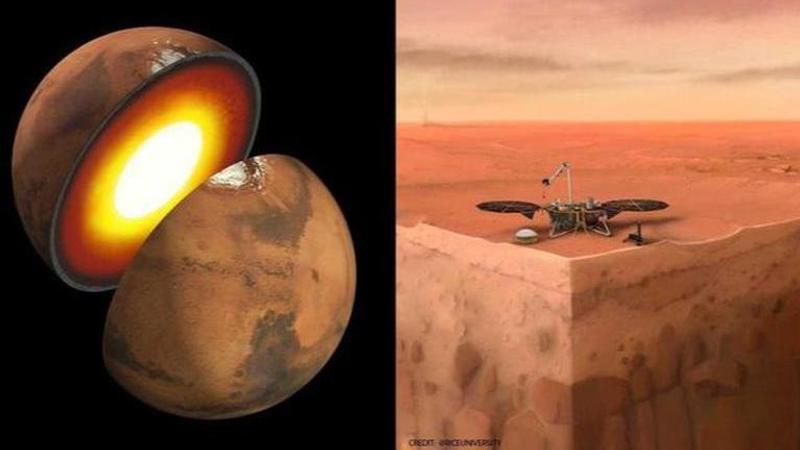Published 20:56 IST, August 6th 2020
Researchers use NASA's InSight lander to study Mars' interior; 3 key findings
Seismologists at Texas' Rice University have made the first direct measurements of three subsurface boundaries from the crust to the core of Mars

Towards a step to better understand the red planet's geology, seismologists at Texas' Rice University have made the first direct measurements of three subsurface boundaries from the crust to the core of Mars using data from NASA’s InSight Lander.
While the thickness of Mars’ crust and the depth of its core have been calculated with a number of models, researchers said the InSight data allowed for the first direct measurements, which can be used to check models and ultimately to improve them. “Ultimately it may help us understand planetary formation,” said Alan Levander, co-author of a study available online this week in Geophysical Research Letters.
One researcher noted that in the absence of plate tectonics on Mars, its early history is mostly preserved compared with Earth. "The depth estimates of Martian seismic boundaries can provide indications to better understand its past as well as the formation and evolution of terrestrial planets in general," said study co-author Sizhuang Deng.
Why seismology matters in study of Mars
Finding clues about Mars’ interior and the processes that formed it are key goals for InSight (short for Interior Exploration using Seismic Investigations), a robotic lander that touched down in November 2018. The probe’s dome-shaped seismometer allows scientists to listen to faint rumblings inside the planet, in much the way that a doctor might listen to a patient’s heartbeat with a stethoscope.
Seismometers measure vibrations from seismic waves. Like circular ripples that mark the spot where a pebble disturbed the surface of a pond, seismic waves flow through planets, marking the location and size of disturbances like meteor strikes or earthquakes, which are aptly called marsquakes on the red planet. InSight’s seismometer recorded more than 170 of these from February to September 2019.
Seismic waves are also subtly altered as they pass through different kinds of rock. Seismologists have studied the patterns in seismographic recordings on Earth for more than a century and can use them to map the location of oil and gas deposits and much deeper strata.
Studying Mars' interior structure answers key questions about the early formation of rocky planets in our inner solar system — Mercury, Venus, Earth, and Mars — more than 4 billion years ago, as well as rocky exoplanets. InSight also measures tectonic activity and meteorite impacts on Mars today.
“The traditional way to investigate structures beneath Earth is to analyze earthquake signals using dense networks of seismic stations,” said Deng. “Mars is much less tectonically active, which means it will have far fewer marsquake events compared with Earth. Moreover, with only one seismic station on Mars, we cannot employ methods that rely on seismic networks,” he adds.
Three interesting findings
Researchers analyzed InSight’s 2019 seismology data using a technique called ambient noise autocorrelation. The technique uses continuous noise data recorded by the single seismic station on Mars to extract pronounced reflection signals from seismic boundaries.
The first boundary researchers measured is the divide between Mars’ crust and mantle almost 22 miles (35 kilometers) beneath the lander.
The second is a transition zone within the mantle where magnesium iron silicates undergo a geochemical change. Above the zone, the elements form a mineral called olivine, and beneath it, heat and pressure compress them into a new mineral called wadsleyite. Known as the olivine-wadsleyite transition, this zone was found 690-727 miles (1,110-1,170 kilometers) beneath InSight.
“The temperature at the olivine-wadsleyite transition is an important key to building thermal models of Mars,” Deng said. “From the depth of the transition, we can easily calculate the pressure, and with that, we can derive the temperature.”
The third boundary the seismologists measured is the border between Mars’ mantle and its iron-rich core, which they found about 945-994 miles (1,520-1,600 kilometers) beneath the lander. Better understanding this boundary “can provide information about the planet’s development from both a chemical and thermal point of view,” Deng said.
About Mars InSight lander:
Updated 20:56 IST, August 6th 2020



